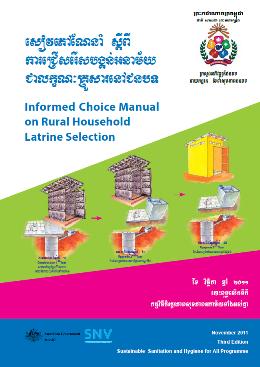Informed Choice Manual on Rural Household Latrine Selection (in English and Cambodian) - Third Edition
SNV and AusAID (2011)

Published in: 2011
Publisher:
Sustainable Sanitation and Hygiene for All Programme, Cambodia
Author:
SNV and AusAID
Uploaded by:
SuSanA secretariat
Partner profile:
common upload
6358 Views
337 Downloads
Location of library entry
Content - Summary
The different types of latrine that can be used in the rural areas are shown in the drawings, together with advantages and disadvantages for each of them. The format makes it easy to present a range of options, and to discuss preferences with villagers.
Once a choice has been made, the latrine construction manual (published separately) can be used to determine detailed construction steps, dimensions, material requirements, etc.
This manual is really meant to be useful to anyone working on sanitation programs in Cambodia. This can mean working on raising awareness of options, and creating sanitation demand, or working in actual construction of latrines. Typical users would include community health workers, NGOs, CBOs, IOs, provincial line departments and so on.
Our hope is to provide some useful tools for raising sanitation demand in Cambodia, but most of all to allow people to make an informed choice about technically feasible and affordable sanitation options.
It is important to note that there are generally two main types of latrine: dry pit latrine and wet pit latrine. While dry pit latrines do not need water for operation, wet pit latrine require flushing water for proper functioning. Therefore, the choice for a dry or wet pit latrine depends predominantly on the availability of water close by.
Bibliographic information
SNV and AusAID (2011). Informed Choice Manual on Rural Household Latrine Selection (in English and Cambodian) - Third Edition. Sustainable Sanitation and Hygiene for All Programme, Cambodia
Filter tags
East Asia & Pacific English Guidelines and manuals Practitioners Rural














